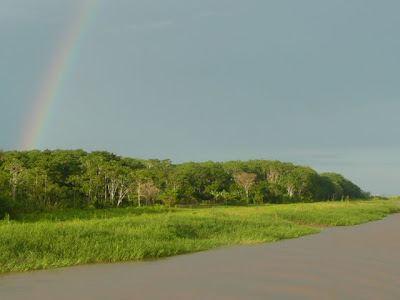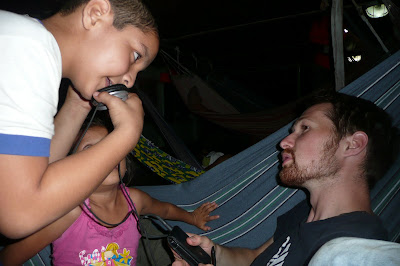Leticia, Colombian Amazon
5-9 June 2010
River Cargo and Passenger Boat Leticia (Colombia) to Iquitos (Peru)
9-12 June 2010
Iquitos, Peru
12 June - now
Heavy rain on the Amazon River sounds like those Indian rain sticks that you turn from end to end as a kind of musical instrument. Until this point I had thought they didn't make a sound like rain. Being that (I believe) those sticks are a product of North American Indians, I imagine they must have listened to rain falling on a large flat body of water like the American great lakes.
The Amazon River is bigger than I had ever imagined, and I only saw it as close as 3000 kms from it's mouth and then continued travelling up river. Even at this distance from its end on the coast of Brazil it's astounding.
I came upriver, that means I´m back in Peru. The Brazilian Consulate in Leticia wanted 3 days to issue my visa. So, applying on Tuesday I wouldn't have had it until Friday and I didn't want to wait that long in Leticia, especially being that I had arrived on Saturday and had already been touristing around. The other bit that bothered me was that they wanted proof (a paid ticket) showing that I would be leaving Brazil. I have a ticket to fly out of Santiago (Chile), and usually this suffices. Obviously, one cannot leave Santiago Chile unless they are first in Santiago Chile, but this doesn´t satisfy the Brazilian Consulate. To satisfy this most overland travellers usually either falsify a bus ticket or buy a fully refundable plane ticket (and then get it fully refunded). But I don´t like red tape, so I walked out of the office, stood on the street thinking, and said "stuff it, I´ll go back to Peru."
And why do they require Australia, USA, and Canadians to get a visa? I don't know. Many people suggest it is monetary and reciprical (we charge them so they charge us) but this type is usually charged at the border without much fuss.
At any rate, coming back to Peru isn´t a bad thing. It´s way cheaper than Brazil. Also, Machu Pichu was closed last time I was near it, and so this gives me a chance to explore it and Cuzco.
I am disappointed that I'm not going to Manuas, it´s a duty free port and I had decided to buy myself a iphone.... figured that way I could write blogs without going to an internet place. Oh well, maybe I will find another good spot to buy one. Of course, Brazil would have been nice too.
In Leticia I took 2 half day tours. The first, kayaking, was really disappointing. Firstly we didn´t kayak very far, then we kayaked back much the same way as we had come. Then the guide suggested we go to the middle of the amazonian lagoon and swim and hopefully the pink dolphins would come and swim with us. Cool, huh! But when we got to the swimming spot and jumped in the river he started propositioning me for sex.... apparently, according to him, it would be an excellent thing to experiment with whilst swimming in an amozonian lagoon. I said no. Apparently I am a hard women... I wonder how many say yes? The guide and I were alone at this point as the rest of the group had paid an extra $100 to boat to a lodge where they would spend the night.
I did complain to the owner of the tour company, and the next tour was much better. It was to the Malokas, or Indian settlements in the jungle. The guide (a different one) taught us about many jungle trees and plants and a lot of walking was involved.
From the kayak.
Rubber production was big in these parts, the guide said those leaf less trees are rubber trees.
Regia Victoria water Lillies grow to 2 metres diameter, the biggest I saw was 1 metre. The big ones apparently can support the weight of a one year one child, I saw one supporting a large bird.
I didn't like the place we canoed to... its main feature was animals for human entertainment, but not well housed or cared for. This is a large snake.
If you imagined big fences of country borders you'd be wrong.... mostly border control in about honestly declaring your intentions. At the end of this road is Brazil, but the hostel is in Colombia.
Those bananas must be heavy.
Fruit market in Leticia
Street food, Leticia, filled with cheese and jam.
Malokas, or indian housing in the jungle.
Whopping tall tree they made the seat out of!
Bit dark inside the big maloka, but I hope you can see the preparation for the birthdayt party which will see 300 attendees in the middle jungle.... it makes you wonder how does a person living in the jungle acquire so many friends?
Slash and burn agriculture. Goodbye Amazon. So sad.
Country folk at home complain about their lack of mobile phone service, but they work here in the amazon. They also worked in the biggest salt flats in the world (Salar de Uyuni), and in the Galapagos Islands.
I think I understood it was sniffing tobacco. It smelled like gunpowder.
Notes
Hostel Mahatu $12.50 per night. It´s ok. The owner comes off as a bit crazy, but I liked his character.
2 tours $50 (so $25 each).... friend of friend deal.
Flight Bogota to Leticia $75.
























































